The Latin American insurance market in 2021
Author: MAPFRE Economics
Summary of report’s conclusions:
MAPFRE Economics
The Latin American insurance market in 2021
Madrid, Fundación MAPFRE, september 2022
The economic environment in which the insurance business is currently operating is surprisingly positive in the Latin American region, where organizations such as the International Monetary Fund have revised growth estimates upwards for some of its main economies, particularly Brazil and Mexico, where the improved economic performance is reflected in their respective insurance markets, with significant growth in the first half of the year and a remarkable recovery in all lines of business, some of them beating the high inflation. However, economic growth estimates for 2023 have been revised down, pointing to a significant deceleration caused by the hardening of financing conditions and the loss of buying power of homes as a result of rising inflation. So, in the next few months the outlook for the region is complex, estimating a significant deceleration in economic growth in 2023 to place it around 1.7% (3.5% in 2022).
In 2021 (the last year for which we have a complete series of data), the insurance market in the Latin American and Caribbean region recovered after the strong downturn experienced the year before thanks to economic growth, as well as an environment of more appropriate interest rates for marketing life savings and income products, produced by the change in orientation in the monetary policy applied by the main central banks of the region, with interest rate hikes in their fight against inflation. Thus, the Latin American insurance market reached a premium volume of 149.79 billion dollars, with an 11.5% increase against -11.9% in 2020. Non-Life insurance premiums, which are 57.5% of the total market, recorded 11.7% growth (-6.1% in 2020) and Life Insurance premiums at 11.2% partially recovered from the strong contraction suffered the previous year (-18.7%) (see Chart 1).
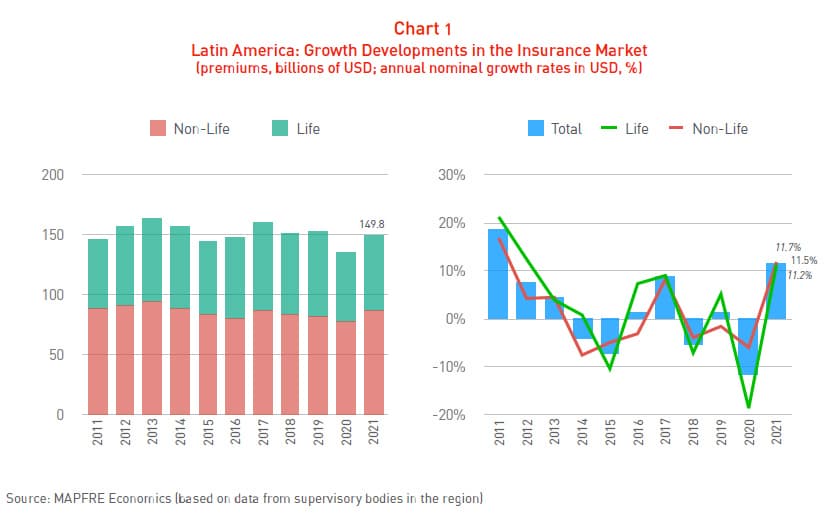
After analyzing insurance activity individually in local currency for each of the markets considered in this report, it is confirmed that the growth in real terms (corrected for the effect of inflation) was practically generalized through the entire region, only recording declines in Ecuador and Venezuela. All other markets presented growth above the previous year, except Argentina and Puerto Rico, which were lower, although in the case of Argentina the switch to inflation-adjusted accounting as of the second half of 2020 makes the comparison not entirely representative (see Chart 2).
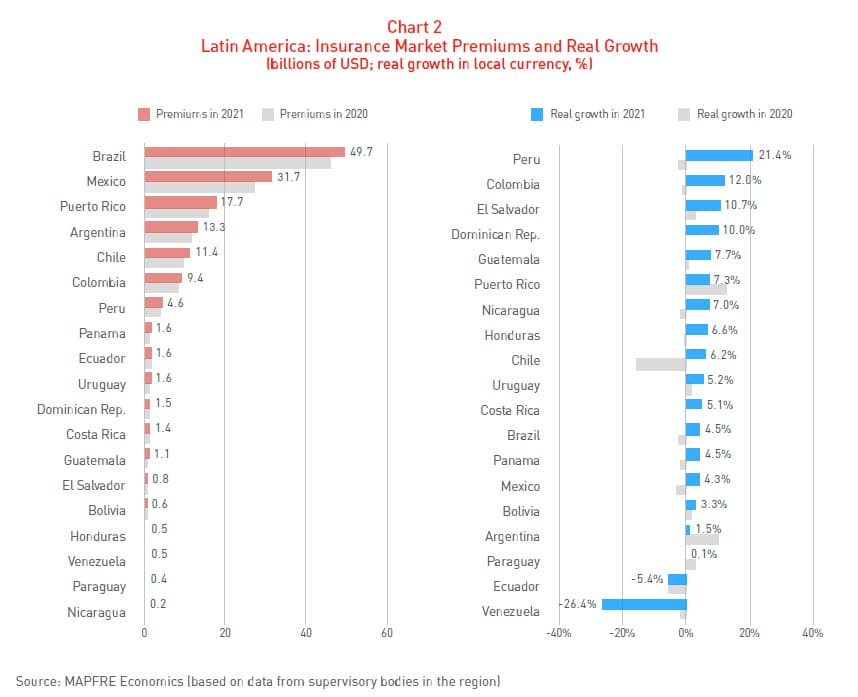
With respect to structural trends, the average penetration index (premiums/GDP) of the region was 3.0% in 2021, 0.1 percentage points (pp) lower than the previous year. This indicator deteriorated in the Non-Life Insurance segment (1.71% versus 1.77% the previous year) and, to a lesser degree, in the Life Insurance segment (1.27% versus 1.31% the previous year). Over the last decade, there has been an upward trend in insurance penetration in the region, to which the development of Life and, to a lesser extent, Non-Life insurance has mainly contributed Although the heavy variations in regional GDP of the last two years and the good performance of Health insurance, as a result of the pandemic, have led to a narrowing of the gap over the decade as a whole with respect to Life insurance when it comes to explaining the increase in insurance penetration in the region.
The density indicator (premiums per capita) were 240 dollars, which is a 10.7% increase over the level of the previous year. The partial recovery of insurance sector premiums in 2021, after the sharp contraction of the previous year due to the economic consequences of the pandemic and the improved behavior of dollar exchange rates, explain this improvement at the density level versus the previous year, although it remains below pre-pandemic levels, due to an insufficient recovery in the Life business. Between 2011 and 2021, density (measured in dollars) shows a downward trend in the region, dropping -6.9% in that period.
And the insurance deepening index in the region (the ratio between Life insurance premiums and total premiums) was 42.5% in 2021, -0.1 pp below the value recorded in 2020. The drop in this indicator was the result of the partial recovery of the Life segment in the large markets of the region, as opposed to Non-Life insurance, which remained over the level prior to the interruption due to the pandemic. All indications are that this circumstance, which particularly affected Life Insurance, will tend to correct itself. In the medium-term analysis (2011-2021) the indicator continues to show improvement over the last decade, with a cumulative increase of 2.2 pp in that period.
Chart 3 shows the comparison of the different countries in the region, based on penetration, density and deepening, indicators that measure the level of development of the respective insurance markets.
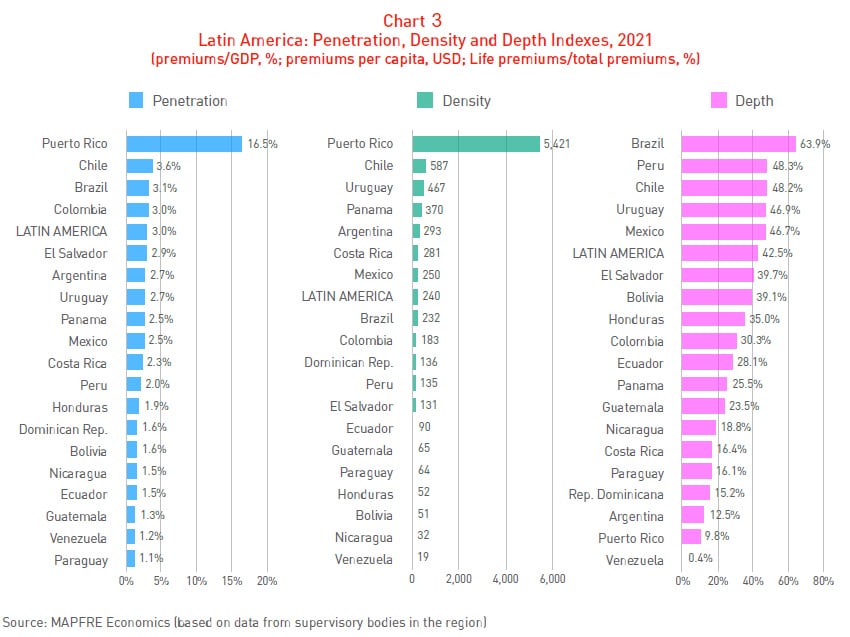
With regard to the Insurance Protection Gap estimate (the difference between insurance coverage that is economically necessary and beneficial to society, and the amount of that coverage effectively acquired) for the Latin American insurance market in 2021, it is 249.8 billion dollars, some 19.7% (41 billion dollars) more than the estimate the previous year. The structure of the IPG does not show significant changes with respect to our previous report, confirming the predominance of Life insurance. Likewise, the potential insurance market in Latin America in 2021 (measured as the sum of the real insurance market and the determined insurance gap) was 399.6 billion dollars (see Chart 4).
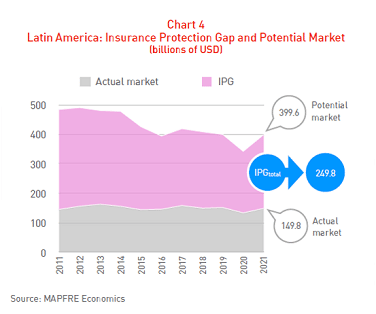
Chart 5 summarizes the evolution of the IPG as a multiple of the real market of the Life and Non-Life segments and the total Latin American insurance market in the last decade, specifically comparing the situation in 2021 versus that of 2011. Over that period of time, improvement in the total insurance gap is evident, especially driven by the reduction of the IPG in the Life segment (the segment with the least relative development in the region), while the Non-Life insurance gap as a multiple of the real market presents a certain stagnation in the reference period.
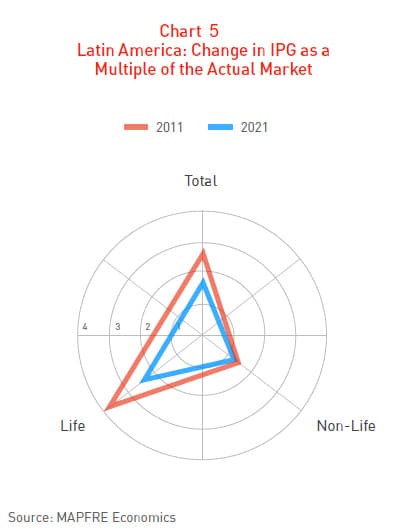
The complete analysis of the behavior and structural trends of the insurance sector in the region can be found in the report The Latin American Insurance Market in 2021, prepared by MAPFRE Economics and available at the following link:




